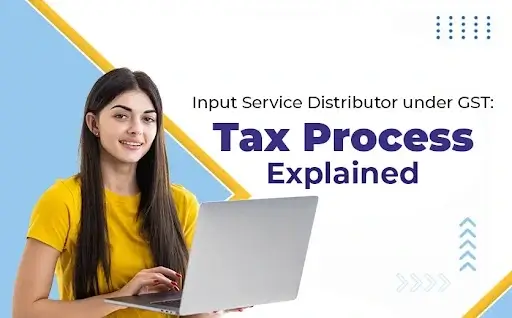
Input Service Distributor under GST: Tax Process Explained
The Goods and Services Tax (GST) regime in India has introduced significant changes to the taxation system. It includes the concept of Input Service Distributor (ISD). Input Service Distributor under GST plays a pivotal role in the distribution of Input Tax Credit (ITC) within a business organization.
If you are looking to learn about the GST concepts then you are at the right place. In this guide, we will explain to you the input service distributor under the GST registration process, eligibility criteria, challenges, and more.
Keep reading to enhance your knowledge and skills to become a perfect GST expert.
Table of Contents
Understanding the ISD Concept
The Input Service Distributor under GST is a unique framework. It is a business entity that receives invoices for input services and is responsible for further distributing Input Tax Credits to other business units of the same company. In essence, an ISD acts as a middleman for the distribution of ITC.
The ISD in the GST mechanism is designed to streamline the distribution of ITC within large organizations with multiple branches or units. It helps to reduce the administrative burden on businesses and ensures that ITC is distributed accurately and efficiently.
Objective of Input Service Distributor in GST
The main goal of introducing the input service distributor under GST is to make it easier for businesses to distribute and use ITC. It allows companies with several business units or branches to centralize ITC distribution and accounting. Thus it makes the process easier and ensures that tax credits are allocated correctly.
In other words, the ISD in GST concept was created to help businesses use ITC more efficiently. This is especially beneficial for large businesses with multiple locations. As it allows them to centralize ITC management and ensure that all units are receiving the correct amount of ITC.
A Comprehensive Guide to GST Basic Concepts for Students
Types of GST in India: IGST, SGST, CGST & UTGST Made Easy for Students
GST Return Types: Due Dates and Filing Procedures
Eligibility Criteria for ISD: Who Can Be an Input Service Distributor?
Not all businesses can register as an Input Service Distributor (ISD) under GST. To be eligible, a business must meet the following criteria:
- Centralized procurement of services: The business must centrally procure services, such as legal, accounting, human resources, or other common services, that will be availed by multiple units or branches within the organization.
- Distinct GST registration: The ISD must have a separate GST registration from its other business verticals or units.
- Distinct invoices: The ISD must receive separate invoices for the input services procured. These invoices must clearly indicate the ISD’s name.
How to Register as an ISD?
To register as an Input Service Distributor under GST, you must follow these steps:
- Visit the GST Portal: Go to the official GST portal (www.gst.gov.in).
- Navigate to the Services Tab: Click on the “Services” tab on the portal.
- Select Registration: Under “Services,” click on “Registration” and then “New Registration.”
- Choose Input Service Distributor: In the “I am a” section, select “Taxpayer” and “Input Service Distributor.”
- Enter Details: Fill in the required details, such as your business’s PAN, email address, mobile number, and the state where the business is registered.
- Verify and Validate Details: After entering the necessary information, the portal will verify and validate the details.
- OTP Verification: You will receive an OTP (One Time Password) on your registered mobile number and email address for verification.
- Upload Documents: Upload the required documents, such as a photograph, constitution of the business, proof of principal place of business, and bank account details.
- Submit the Application: Once all details and documents are submitted, the application is reviewed by the GST authorities. If everything is in order, the registration certificate is issued.
Appointing an ISD
Once registered as an Input Service Distributor Under GST, a business can appoint a person or employee as the ISD. This selected individual will be responsible for distributing ITC to other business units or branches within the organization.
The ISD in GST must be a person who is authorized to act on behalf of the business. This could be an employee, a director, or a partner.
To appoint an ISD in GST, the business must submit a Form ISD-01 to the GST authorities. The form must include the following information:
- The name and address of the business
- The GST registration number of the business
- The name and address of the appointed ISD
- The date of appointment
Once Form ISD-01 has been submitted and approved by the GST authorities, the appointed ISD will be able to start distributing ITC to other business units or branches within the organization.
GST Reporting: Complete Overview of 2-Factor Authentication in GST
GST HSN Codes List: Find the Right Code for Your Products
Reverse Charge Mechanism: Key Concepts and Implications
Distribution of Input Tax Credit (ITC)
Process of Distributing ITC
The ISD process follows a structured workflow to distribute Input Tax Credit (ITC) to business units or branches within an organization.
Step 1: Procurement of Input Services
The ISD centrally procures input services, such as accounting, legal, or IT services, on behalf of multiple business units or branches. The invoices for these services are addressed to the ISD.
Step 2: Apportioning ITC
The ISD calculates the total ITC available based on the invoices it has received. It then apportions the available ITC to the respective business units or branches that will utilize these services.
The apportionment is typically based on the ratio of each business unit or branch’s turnover to the total turnover of the organization.
Step 3: Filing GST Form GSTR-6
The ISD is required to file monthly returns using GST Form GSTR-6. This return provides details of the ITC received and distributed during the month.
Step 4: Claim by Units
The business units or branches receiving the ITC can claim it in their respective returns.
Step 5: Utilization
The recipients of ITC can use the credit to offset their GST liability on outward supplies, reducing their overall tax liability.
Using GST Form GSTR-6
The Input Service Distributor uses Form GSTR-6 for the following purposes:
- Disclose all ITC received by the ISD on behalf of its business units.
- Distribute the ITC to the business units based on their usage.
- File a monthly return with the GST authorities to report the ITC received and distributed during the month.
Form GSTR-6 is a critical document for ISDs, as it ensures that the ITC is distributed accurately and efficiently. It also helps businesses to comply with the GST law.
Input Service Distributor vs. Regular Dealer
| Characteristic | ISD | Regular dealer |
|---|---|---|
| Nature of business | Distributes ITC within an organization | Conducts transactions involving the supply of goods and services to customers |
| GST registration | Separate GST registration | Single GST registration for the entire business |
| Invoices | Receives invoices for input services | Receives invoices for the sale of goods and services |
| Tax liability | No tax liability | Responsible for collecting and remitting GST to the government |
| Returns | Files GSTR-6 to report the distribution of ITC | Files GSTR-1 for outward supplies and GSTR-3B for monthly summary returns |
Check out the learning options in GST courses here that make you industry ready with hands-on experience.

Challenges and Compliance for ISD
Ensuring Accurate ITC Distribution
One of the key challenges for an Input Service Distributor under GST is ensuring that Input Tax Credit (ITC) is accurately distributed to the various business units. Any discrepancies or errors in distribution can lead to compliance issues and the loss of legitimate tax credits.
Complying with GST Regulations
Input Service Distributors (ISDs) must be meticulous in complying with GST regulations. This includes:
- Timely filing of Form GSTR-6: ISDs must file Form GSTR-6 on time to report the distribution of ITC. Late filing of Form GSTR-6 can result in penalties.
- Accurate reporting of ITC: ISDs must accurately report all ITC received and distributed on Form GSTR-6. Inaccurate reporting of ITC can lead to compliance issues and penalties.
- Adherence to GST guidelines: ISDs must adhere to all GST guidelines, including those related to ITC distribution. Non-compliance with GST guidelines can result in penalties and legal repercussions.
Conclusion
ISDs are intermediaries that help businesses distribute ITC to their various branches or units. This can be a complex and time-consuming process, especially for large organizations with multiple locations. ISDs automate this process, making it more efficient and accurate.
ISDs also help businesses to comply with GST regulations. By ensuring that ITC is distributed correctly, ISDs can help businesses avoid penalties and fines from the GST authorities.
GST Training FAQs for Students – Your Top Questions Answered
Time of Supply in GST Explained
Simplifying Accounting: E-Invoice in Tally Prime
Mastering SAC Codes: Key to GST Compliance
GST Reconciliation in TallyPrime: A Comprehensive Guide with Real-Life Examples
Indian Accounting Standards – Get an Overview Of What They Are
- Professional Courses For Commerce Students With High Pay - December 5, 2025
- Job Guarantee Vs Job Assistance: Core Points Of Differences Between The Two - November 28, 2025
- Beginners Guide To Power BI Dashboard - November 28, 2025

.jpg)



















